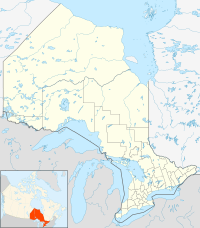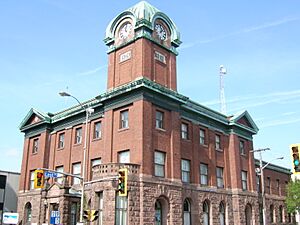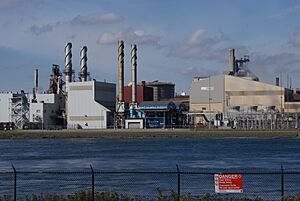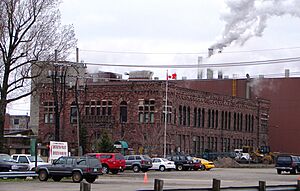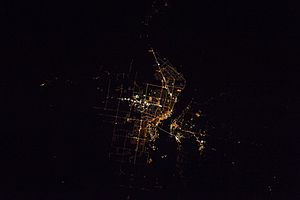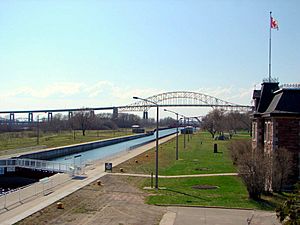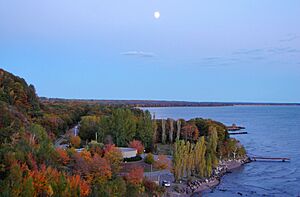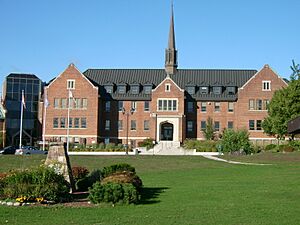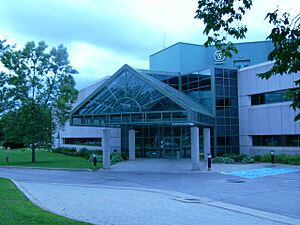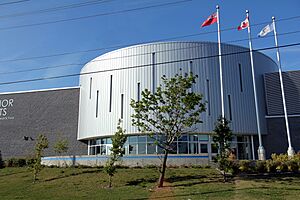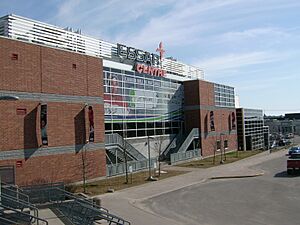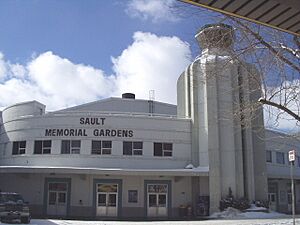Sault Ste. Marie, Ontario facts for kids
Quick facts for kids
Sault Ste. Marie
|
|
|---|---|
| City of Sault Ste. Marie | |
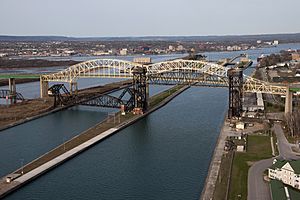
Soo Locks International Bridge, (North) Downtown Sault Ste. Marie, Ontario
|
|
| Nickname(s):
"The Soo"
|
|
| Motto(s):
"Naturally Gifted"
|
|
| Country | Canada |
| Province | Ontario |
| District | Algoma |
| Founded | 1668 |
| Incorporated | 1888 (town) 1912 (city) |
| Government | |
| • Type | Mayor-Council |
| Area | |
| • Land | 223.24 km2 (86.19 sq mi) |
| • Urban | 53.05 km2 (20.48 sq mi) |
| • Metro | 805.60 km2 (311.04 sq mi) |
| Elevation | 192 m (630 ft) |
| Population
(2021)
|
|
| • City (single-tier) | 72,051 |
| • Density | 324.6/km2 (841/sq mi) |
| • Metro | 76,731 |
| • Metro density | 95.6/km2 (248/sq mi) |
| Demonym(s) | Saultite |
| Time zone | UTC−05:00 (EST) |
| • Summer (DST) | UTC−04:00 (EDT) |
| Forward sortation area |
P6A to P6C
|
| Area code(s) | 705, and 249 |
| CA rank: 46th in Canada Municipal rank: 66th in Canada |
|
Sault Ste. Marie (pronounced SOO-saynt-MƏ-ree) is a city in Ontario, Canada. People often call it "The Soo." It is the third-largest city in Northern Ontario.
The city is located on the St. Mary's River. This river forms part of the Canada-US border. Across the river is another city with the same name, Sault Ste. Marie, Michigan, in the United States. The two cities are connected by the Sault Ste. Marie International Bridge.
Large ships traveling through the Great Lakes use the American Soo Locks to bypass the rapids in the river. These locks are some of the busiest in the world. Smaller boats and tour ships use the Canadian Sault Ste. Marie Canal.
The Ojibwe people, who are the original inhabitants of this area, call it Baawitigong. This means "place of the rapids." They used this spot as a meeting place during the whitefish fishing season. French settlers later called the rapids Les Saults de Ste-Marie, which means "the rapids of St. Marie." The city's name comes from this. The word sault means "rapids" or "falls."
Sault Ste. Marie is surrounded by other areas. To the east are the Rankin and Garden River First Nations reserves. To the west is Prince Township. North of the city is an undeveloped part of Algoma District. In 2011, the total population of Sault Ste. Marie and its nearby areas was about 79,800 people.
Native American groups, mostly Ojibwe speakers, lived here for over 500 years. In the late 1600s, French missionaries built a mission on the south side of the river. Later, a fur trading post grew, attracting traders and Native Americans to the area.
For a long time, the community on both sides of the river was seen as one. After the War of 1812 between Britain and the United States, the border was set along the St. Mary's River. The US then stopped British traders from working in its territory. This caused the two sides of the river to develop into separate communities, both called Sault Ste. Marie.
Contents
- Exploring the Past of Sault Ste. Marie
- Weather in Sault Ste. Marie
- Understanding Sault Ste. Marie's Economy
- Sault Ste. Marie's Green Energy Focus
- Getting Around Sault Ste. Marie
- Fun Things to Do in Sault Ste. Marie
- People of Sault Ste. Marie
- Learning and Education
- Sports in Sault Ste. Marie
- Sault Ste. Marie Walk of Fame
- Culture and Arts
- Famous People from Sault Ste. Marie
- Media in Sault Ste. Marie
- Cities Sault Ste. Marie is Connected To
- See also
Exploring the Past of Sault Ste. Marie
Early Beginnings
In 1623, a French explorer named Étienne Brûlé visited this area. The French called the rapids Sault de Gaston to honor Gaston, Duke of Orléans, who was the brother of King Louis XIII of France.
In 1668, French missionaries from the Jesuit order renamed it Sault Sainte-Marie. They started a mission settlement on the river's south bank. This is where Sault Ste. Marie, Michigan is today.
Later, a fur trading post was set up, and the settlement grew on both sides of the river. Sault Ste. Marie is one of the oldest French settlements in North America. It was a key point on the 3,000-mile fur trade route. This route went from Montreal to Sault Ste. Marie and further north. Many different people lived here, including Europeans, First Nations, and Métis.
The city's name comes from Saults de Sainte-Marie, which is old French for "Saint Mary's Falls." This refers to the rapids in the Saint Marys River. The word sault meant a waterfall or rapids. In modern French, people use chutes or rapides instead.
Traders often met with different Indigenous tribes from around the Great Lakes. When the English took control of French areas in Canada, their traders became more important. A Scottish-British fur trader named John Johnston and his Ojibwe wife, Ozhaguscodaywayquay, were very important in the late 1700s. They often welcomed important visitors from both the US and Canada. Their children learned English, Ojibwe, and French. Their daughter, Jane Johnston, became known as the first Native American poet and writer in the United States.
The War of 1812 and Its Effects
The friendly atmosphere changed during and after the War of 1812. Trade slowed down. On July 20, 1814, American forces destroyed a trading post on the north side of the St. Marys River. After the war, the border was officially drawn, and the US stopped British Canadian traders from working in its territory. This caused the communities on each side of the river to grow separately.

In 1870, the United States did not allow a Canadian ship carrying Colonel Garnet Wolseley to pass through their locks at Sault Ste. Marie. To have their own way to move ships, Canadians built the Sault Ste. Marie Canal, which was finished in 1895.
Connecting by Rail
Building a railway to Sault Ste. Marie was planned in the 1880s. There was a lot of debate about whether the main Canadian Pacific Railway line should go through the city. Some wanted it to connect to American railways, while others wanted an all-Canadian route.
Eventually, a new main railway line was built through Northern Ontario, bypassing Sault Ste. Marie. This led to the growth of Sudbury District when minerals were discovered there. The original railway line to Sault Ste. Marie was completed later, connecting with American railways.
Sault Ste. Marie, Ontario, became a town in 1888. However, its economy slowed down as the fur trade declined.
The 20th Century and Beyond
In 1912, Sault Ste. Marie officially became a city.
During World War II, people worried about protecting the locks and shipping channel in Sault Ste. Marie. A strong military presence was set up to guard against possible attacks. Anti-aircraft defenses and radar bases were installed in northern Ontario. However, by 1943, most of these defenses were removed, as they were no longer considered necessary.
A Canadian Navy ship, HMCS Sault Ste. Marie, was named after the city. It helped protect convoys during the war.
In 1990, the city council passed a resolution declaring English as the city's only official language for city services. This caused a lot of discussion and disagreement, especially because many French-speaking people live in the city. The resolution was later overturned by a court in 1994.
Weather in Sault Ste. Marie
Sault Ste. Marie has a humid continental climate. This means it has cold, snowy winters and warm, humid summers. Lake Superior helps to make the summer weather a bit milder. Winters usually start in mid-November and last until early April. Temperatures can drop below -20°C about 26 days a year. Summers are warm, with temperatures above 30°C about 12 days a year. The city gets a lot of rain and snow throughout the year. The wettest months are from September to November.
| Climate data for Sault Ste. Marie (Sault Ste. Marie Airport), WMO ID: 71260; coordinates 46°29′00″N 84°30′34″W / 46.48333°N 84.50944°W; elevation: 192 m (630 ft); 1991–2020 normals, extremes 1889–present |
|||||||||||||
|---|---|---|---|---|---|---|---|---|---|---|---|---|---|
| Month | Jan | Feb | Mar | Apr | May | Jun | Jul | Aug | Sep | Oct | Nov | Dec | Year |
| Record high humidex | 7.8 | 8.7 | 28.0 | 31.6 | 38.6 | 40.9 | 42.9 | 42.7 | 39.5 | 34.4 | 21.6 | 19.2 | 42.9 |
| Record high °C (°F) | 8.6 (47.5) |
12.0 (53.6) |
26.7 (80.1) |
30.0 (86.0) |
32.3 (90.1) |
34.4 (93.9) |
37.2 (99.0) |
36.1 (97.0) |
35.0 (95.0) |
27.8 (82.0) |
21.7 (71.1) |
15.4 (59.7) |
37.2 (99.0) |
| Mean daily maximum °C (°F) | −5.0 (23.0) |
−4.0 (24.8) |
1.4 (34.5) |
8.7 (47.7) |
16.2 (61.2) |
21.8 (71.2) |
24.2 (75.6) |
23.7 (74.7) |
19.4 (66.9) |
11.7 (53.1) |
4.8 (40.6) |
−1.0 (30.2) |
10.2 (50.4) |
| Daily mean °C (°F) | −9.8 (14.4) |
−9.4 (15.1) |
−4.1 (24.6) |
3.4 (38.1) |
9.9 (49.8) |
15.2 (59.4) |
17.9 (64.2) |
17.7 (63.9) |
13.7 (56.7) |
7.2 (45.0) |
1.2 (34.2) |
−4.8 (23.4) |
4.8 (40.6) |
| Mean daily minimum °C (°F) | −14.5 (5.9) |
−14.7 (5.5) |
−9.6 (14.7) |
−2.0 (28.4) |
3.5 (38.3) |
8.5 (47.3) |
11.6 (52.9) |
11.5 (52.7) |
8.0 (46.4) |
2.7 (36.9) |
−2.5 (27.5) |
−8.6 (16.5) |
−0.5 (31.1) |
| Record low °C (°F) | −41.1 (−42.0) |
−39.4 (−38.9) |
−36.7 (−34.1) |
−28.9 (−20.0) |
−8.9 (16.0) |
−5.6 (21.9) |
−2.8 (27.0) |
−3.3 (26.1) |
−8.3 (17.1) |
−13.3 (8.1) |
−32.8 (−27.0) |
−36.7 (−34.1) |
−41.1 (−42.0) |
| Record low wind chill | −44.8 | −42.3 | −40.5 | −27.8 | −10.0 | −4.3 | 0.0 | 0.0 | −6.0 | −13.9 | −29.2 | −42.8 | −44.8 |
| Average precipitation mm (inches) | 65.1 (2.56) |
45.6 (1.80) |
52.3 (2.06) |
71.0 (2.80) |
68.6 (2.70) |
79.3 (3.12) |
76.9 (3.03) |
77.9 (3.07) |
108.6 (4.28) |
110.5 (4.35) |
89.0 (3.50) |
69.9 (2.75) |
914.7 (36.01) |
| Average rainfall mm (inches) | 8.6 (0.34) |
5.9 (0.23) |
21.8 (0.86) |
55.2 (2.17) |
67.7 (2.67) |
79.3 (3.12) |
76.9 (3.03) |
77.9 (3.07) |
108.5 (4.27) |
105.7 (4.16) |
53.7 (2.11) |
17.0 (0.67) |
678.2 (26.70) |
| Average snowfall cm (inches) | 83.7 (33.0) |
58.7 (23.1) |
38.7 (15.2) |
17.3 (6.8) |
0.9 (0.4) |
0.0 (0.0) |
0.0 (0.0) |
0.0 (0.0) |
0.1 (0.0) |
4.8 (1.9) |
43.6 (17.2) |
77.2 (30.4) |
324.9 (127.9) |
| Average precipitation days (≥ 0.2 mm) | 20.2 | 15.3 | 13.8 | 11.7 | 12.1 | 11.6 | 12.7 | 10.7 | 14.9 | 17.6 | 17.6 | 19.0 | 177.2 |
| Average rainy days (≥ 0.2 mm) | 3.2 | 2.1 | 5.4 | 9.1 | 11.8 | 11.6 | 12.7 | 10.7 | 14.9 | 16.5 | 10.0 | 4.6 | 112.7 |
| Average snowy days (≥ 0.2 cm) | 19.4 | 14.9 | 10.6 | 4.6 | 0.52 | 0.0 | 0.0 | 0.0 | 0.16 | 2.2 | 11.5 | 16.8 | 80.6 |
| Average relative humidity (%) (at 15:00) | 73.9 | 69.9 | 63.6 | 56.6 | 54.6 | 58.9 | 60.8 | 61.7 | 64.2 | 68.2 | 73.6 | 76.9 | 65.3 |
| Mean monthly sunshine hours | 72.8 | 109.9 | 150.3 | 182.2 | 240.2 | 265.8 | 266.3 | 240.9 | 154.7 | 119.1 | 61.8 | 55.8 | 1,919.7 |
| Percent possible sunshine | 26.0 | 37.9 | 40.8 | 44.8 | 51.7 | 56.3 | 55.7 | 54.8 | 40.9 | 35.1 | 21.8 | 20.8 | 40.6 |
| Source: Environment and Climate Change Canada | |||||||||||||
Understanding Sault Ste. Marie's Economy
Sault Ste. Marie has a history of strong industries, especially steel-making. Algoma (formerly Algoma Steel) is the biggest employer, with thousands of workers. During World War II, steel and chromium from Sault Ste. Marie were very important for making military vehicles.
The Huron Central Railway is also important for the steel industry. Over the years, Algoma has faced financial challenges but has also seen periods of growth, especially when the demand for steel increased. In 2007, Essar Group from India bought the company.
Forestry is another major industry. While St. Mary's Paper mill has closed and reopened at different times, other wood product companies like ARAUCO still operate. These companies employ many people in the community.
The city also had several call centres, which provided about 1,500 jobs. However, some of these call centers have closed down.
The Ontario Lottery and Gaming Corporation (OLG) is another large employer. The OLG has a main office and a casino in Sault Ste. Marie, employing about 900 people.
Sault Ste. Marie is one of the few cities in Ontario where stores are not allowed to open on December 26, which is Boxing Day. Sales start on December 27 instead. In 2010, voters had a chance to change this rule, but most people voted against allowing stores to open on Boxing Day.
Sault Ste. Marie's Green Energy Focus
Sault Ste. Marie is working to become a leader in alternative energy. It has a large Sault Ste. Marie Solar Park and other power plants that use renewable energy sources. These include a co-generation plant, a hydroelectric station, and the nearby Prince Township Wind Farm. Two more wind farms are planned for the area.
The city is also exploring ways to turn waste into energy. The local Public Utilities Commission (PUC) collects methane gas from the city's landfill. All of the city's street lights use LED technology. The city plans to start buying electric vehicles for its fleet in 2022. Heliene, a company that makes solar energy equipment, has its headquarters here.
In 2021, the city and the PUC started the Sault Smart Grid (SSG) Project. This project uses new technology to make electricity use more efficient. It aims to lower electricity costs for homes and businesses. It will also help reduce power outages and make the power supply more reliable. The SSG officially started in November 2023.
Getting Around Sault Ste. Marie
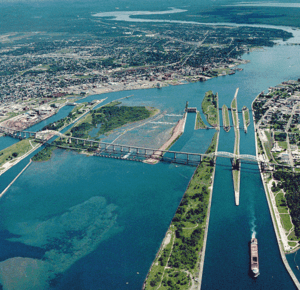
Sault Ste. Marie is connected by Highway 17, which is part of the Trans-Canada Highway. This highway links the city to Thunder Bay in the northwest and Sudbury in the east. The International Bridge connects downtown Sault Ste. Marie to Sault Ste. Marie, Michigan. On the American side, it becomes Interstate 75, which goes all the way to Florida.
A newer road called "Carmen's Way" helps trucks get to Highway 17 easily. The city is also important for marine transportation because of the locks on the St. Lawrence Seaway. The city has its own small lock for small boats. A new terminal helps move goods by rail, road, and water.
Cruise ships often stop at Roberta Bondar Park. This park has a pavilion, a farmers market, and overlooks the St. Mary's River.
Sault Ste. Marie has an airport, Sault Ste. Marie Airport, and a local bus service, Sault Transit Services. While there is no longer passenger train service to other major cities, the Algoma Central Railway runs north from the city to Hearst. In 2018, Ontario Northland started bus services connecting Sault Ste. Marie to other northern communities.
For ridesharing, the city has URide, EZ Ride, and Driverseat. Taxi services are also available.
Fun Things to Do in Sault Ste. Marie
There are many attractions in Sault Ste. Marie. You can visit the Canadian Bushplane Heritage Centre, the Entomica Insectarium, or the Sault Ste. Marie Museum. The Sault Ste. Marie Canal National Historic Site is also a great place to explore. You can take boat tours of the Sault locks or visit Whitefish Island.
Other interesting places include the Ermatinger Clergue National Historic Site, Casino Sault Ste. Marie, and the Art Gallery of Algoma. The Algoma Central Railway offers a popular Agawa Canyon Tour Train, which takes you on a beautiful wilderness trip.
Nearby parks include Pancake Bay Provincial Park, Batchawana Bay Provincial Park, and Lake Superior Provincial Park. In winter, you can enjoy the annual Bon Soo Winter Carnival. Searchmont Resort is a great place for skiing and snowboarding. There are also cross-country ski trails at Stokely Creek Lodge and Hiawatha. The city has a large snowmobile trail system too.
The John Rowswell Hub Trail] is a 25 km path around the city. It's perfect for walking, rollerblading, cycling, snowshoeing, and cross-country skiing. The Voyageur Hiking Trail also starts in Sault Ste. Marie.
Roberta Bondar Park and Pavilion is a famous spot with a unique tent design. It's named after the first Canadian female astronaut in space. The park often hosts community events and has a farmers market.
Sault Ste. Marie has a great network for mountain biking. More trails are being added to the existing 30-40 km network.
One of the biggest attractions from June to October is the Agawa Canyon Tour Train. This train ride takes you 114 miles north through beautiful northern lakes, rivers, and forests. It ends at the Agawa Canyon. A new train station for the tour train opened in 2021.
The city is also home to the Station Mall, one of the largest shopping malls in Northern Ontario.
In 2020, the city council decided to build a new downtown plaza. This plaza will have a fountain that can be used for skating in winter, restrooms, a large screen, and event space. It will also include the Mill Market and other businesses. Construction is expected to start in Spring 2022.
People of Sault Ste. Marie
| Historical populations | ||
|---|---|---|
| Year | Pop. | ±% |
| 1871 | 879 | — |
| 1881 | 780 | −11.3% |
| 1891 | 2,414 | +209.5% |
| 1901 | 7,169 | +197.0% |
| 1911 | 10,984 | +53.2% |
| 1921 | 21,092 | +92.0% |
| 1931 | 23,082 | +9.4% |
| 1941 | 25,620 | +11.0% |
| 1951 | 32,452 | +26.7% |
| 1961 | 43,088 | +32.8% |
| 1971 | 80,332 | +86.4% |
| 1981 | 82,697 | +2.9% |
| 1991 | 81,476 | −1.5% |
| 1996 | 80,054 | −1.7% |
| 2001 | 74,566 | −6.9% |
| 2006 | 74,948 | +0.5% |
| 2011 | 75,141 | +0.3% |
| 2016 | 73,368 | −2.4% |
| 2021 | 72,051 | −1.8% |
| Religions in Sault Ste. Marie | ||||
|---|---|---|---|---|
| Religion | Percent | |||
| No Religion/Secular | 38% | |||
| Catholic Christian | 33% | |||
| Protestant Christians | 16% | |||
| Christian N.O.S | 5% | |||
| Other Christian/Christian-Related Tradition | 4% | |||
| Other Religions | 3% | |||
| 2021 Census Profile | ||||
In 2021, Sault Ste. Marie had a population of 72,051 people. This was a small decrease from 2016. The city's total population, including nearby areas, was 76,731.
Sault Ste. Marie has a large number of people of Italian origin for its size. Most of them came from the southern region of Calabria.
About 82% of the population is of European background. Indigenous peoples make up about 13.5%, and other visible minorities are about 4.5%.
In 2019, the Canadian government started a program called the Rural and Northern Immigration Pilot. This program helps skilled workers move to northern communities like Sault Ste. Marie.
Learning and Education
Sault Ste. Marie is home to Sault College, which offers many applied arts and technology programs. It also has Algoma University. Both schools work with Lake Superior State University in Michigan to offer some joint programs. In 2008, Algoma University became an independent university. A new school, Shingwauk Kinoomaage Gamig, plans to open and offer courses in Anishinaabe culture and language.
The city has two main school boards: the Algoma District School Board (public) and the Huron-Superior Catholic District School Board. It also has French-language school boards.
Here are some of the high schools in Sault Ste. Marie:
- Korah Collegiate & Vocational School (English, public)
- École Notre-Dame-du-Sault (French, Catholic)
- St. Mary's College (English with French Immersion, Catholic)
- Superior Heights Collegiate & Vocational School (English and French Immersion, public)
- White Pines Collegiate & Vocational School (English, public)
Sault Ste. Marie is also home to the Ontario Forest Research Institute and the federal Great Lakes Forestry Centre. There are over 30 elementary schools in the city.
Sports in Sault Ste. Marie
The Sault Ste. Marie Greyhounds are the city's most famous sports team. They are a hockey team that has been around since 1919. The Greyhounds have won national championships, including the Memorial Cup in 1993. They play at the GFL Memorial Gardens, a modern arena. Many famous hockey players have played for the Greyhounds, including Joe Thornton, John Vanbiesbrouck, Craig Hartsburg, Ron Francis, Adam Foote, and Wayne Gretzky. Their jerseys are retired to honor their achievements.
Sault Ste. Marie also had a team in the first professional hockey league, called the Sault Ste. Marie Marlboros. Many Hockey Hall of Fame members have connections to Sault Ste. Marie.
Other notable NHL players from the Sault Ste. Marie area include Tyler Kennedy, Jordan Nolan, and Chris Thorburn. Currently, Colin Miller plays for the Winnipeg Jets.
Paul Maurice, a Sault Ste. Marie native, is the current coach of the NHL's Florida Panthers. He led them to their first Stanley Cup in 2024. Former Greyhound player and coach Ted Nolan also coached in the NHL and won the Jack Adams Trophy as Coach of the Year in 1998.
Sault Ste. Marie hosted the Canadian men's curling championship, the Tim Hortons Brier, in 1990. In 2010, it hosted the Scotties Tournament of Hearts, the Canadian women's curling championship. In 2013, the team from the Soo Curlers Association, led by Brad Jacobs, won the Brier. They went on to win a silver medal at the World Championship and a gold medal at the 2014 Winter Olympics.
The city also has a strong history in Canadian football. High school teams often win regional honors. The Sault Steelers are a semi-pro football team that has won national championships multiple times.
Other famous athletes from Sault Ste. Marie include football player Rocky Dipietro, Paralympic swimmer Jessica Tuomela, and mixed martial artist Antonio Carvalho.
Sault Ste. Marie has hosted many national and international sporting events, like the Eco-Challenge North American Championship in 2003, which was a long adventure race.
Sault Ste. Marie Walk of Fame
The Walk of Fame was started in 2006. It honors people from Sault Ste. Marie or the Algoma District who have made great contributions to the community or in their chosen careers. New people are added every year.
Culture and Arts
Sault Ste. Marie is home to the Bon Soo winter carnival, which happens every February. The city also hosts the annual Algoma Fall Festival, featuring local and international artists. Performances take place at the Kiwanis Community Theatre and the Central United Church. The Art Gallery of Algoma has a large collection of art and hosts regular exhibitions.
Residents celebrate Community Day on the third weekend of July. The local Rotary International club organizes a three-day event called Rotaryfest.
Sault Ste. Marie was featured in Kalle Mattson's song "A Love Song to the City." Film director Egidio Coccimiglio, who grew up in the city, has filmed two movies in the area.
Famous People from Sault Ste. Marie
- Wayne Gretzky, legendary NHL player
- Brigitte Acton, two-time Olympic alpine skier
- Michael Amadio, NHL player
- David Amber, sports reporter
- Ivan Boldirev, retired NHL player
- Roberta Bondar, first Canadian female astronaut
- Antonio Carvalho, mixed martial artist
- Treble Charger, Juno Award-nominated band
- Kyle Dubas, general manager of the Pittsburgh Penguins
- Steve Wochy, former NHL player
- Phil Esposito, Hockey Hall of Fame member
- Tony Esposito, Hockey Hall of Fame member
- Aaron Fiacconi, retired CFL player
- Ron Francis, Hockey Hall of Fame member
- William Howard Hearst, former Premier of Ontario
- Kevin Hodson, retired NHL goalie
- Brad Jacobs, E. J. Harnden, Ryan Harnden, Olympic gold medalist curlers
- David Johnston, former Governor General of Canada
- Sharon Johnston, Viceregal Consort
- Lila Kedrova, Academy Award-winning actress
- Tyler Kennedy, former NHL player
- Jerry Korab, retired NHL player
- Chico Maki, former NHL player
- Wayne Maki, former NHL player
- Mac Marcoux, Paralympic alpine skier
- Kalle Mattson, folk rock musician
- Paul Maurice, NHL coach
- Bob McKenzie, hockey broadcaster
- Colin Miller, NHL player
- Jordan Nolan, former NHL player
- Ted Nolan, former NHL player and coach
- John Parco, retired hockey player
- Didier Pitre, Hockey Hall of Fame member
- Crystal Shawanda, Juno Award-winning country singer
- Ray Smillie, Olympic bronze medalist boxer
- Lyndon Slewidge, anthem singer
- Chris Thorburn, former NHL player
- Jessica Tuomela, Paralympic swimmer
- Marty Turco, retired NHL goalie
- Tanya Kim, TV personality
- Gene Ubriaco, retired NHL player and coach
- Brian Vallée, author and filmmaker
- Dennis Vial, retired NHL player
- Jonathan Wilkinson, federal cabinet minister
Media in Sault Ste. Marie
Cities Sault Ste. Marie is Connected To
Sault Ste. Marie has "sister cities" around the world. These are cities that have a special friendship and cultural exchange.
- County Louth, Ireland
- Forssa, Finland
- Maia, Portugal
- Sault Ste. Marie, Michigan, United States (also its twin city across the border)
See also
 In Spanish: Sault Ste. Marie (Ontario) para niños
In Spanish: Sault Ste. Marie (Ontario) para niños


